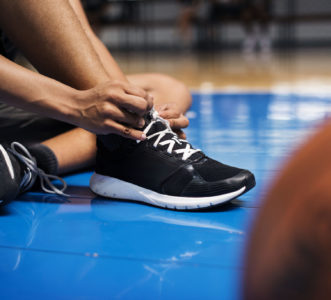 The high school basketball season is here, and soon many teens will be lacing up their shoes and taking the court with hopes of making the team or helping them win conference. Whether you’re playing high school sports or you just like to play pickup games at the gym, basketball can be every hard on your lower body, especially your feet. Today, we want to share some tips for protecting your legs and feet while playing basketball.
The high school basketball season is here, and soon many teens will be lacing up their shoes and taking the court with hopes of making the team or helping them win conference. Whether you’re playing high school sports or you just like to play pickup games at the gym, basketball can be every hard on your lower body, especially your feet. Today, we want to share some tips for protecting your legs and feet while playing basketball.
Preventing Foot Injuries in Basketball
From the quick movements to the hard surface its played on, basketball can be tough on your feet. Here’s how to reduce your likelihood of a lower body injury.
1. Right Size Basketball Shoe – You want to make sure that your choice of footwear is the correct size. If they’re too loose, it won’t really be supporting your ankles and can lead to rolled or sprained ankles, and if they’re too tight, it can limit circulation or put extra pressure on your toes and toenails, which can lead to problems like bunions or ingrown toenails. Don’t just assume the shoes from last year will still fit, make sure you have the right sized shoe. Also, make sure they are designed for basketball, this way the tread of the shoe will be designed to provide traction and stability when running across the court.
2. Ankle Support – Ankle sprains are the most common injury in basketball, and while they aren’t 100 percent preventable, you can reduce your risk by ensuring you have plenty of ankle support. You can do this by purchasing an ankle brace or orthotic support, or you can get a mid- or high-top basketball shoe that helps to provide extra stability to your ankle. Strength training or physical therapy to improve ankle ligament and muscle strength is another way to prevent sprains.
3. Stretch – You’ll also want to make a habit of stretching both before and after a game or practice. Stretching helps to ensure muscles are ready for the upcoming activity, and it helps them stay loose once the final whistle has blown. Stretching can help prevent muscle tears or tendon ruptures, so give yourself at least five minutes before and after a practice or game to stretch your upper or lower body.
4. Cross Train – One thing that I always tell the young athletes that come through my clinic is that one of the best things they can do for themselves in one sport is to cross train with another sport in the offseason. If you play basketball in the winter, do basketball camps in the spring, play recreational league in the summer and then start training for the winter season, you’re only going to be working the same muscle groups. This can lead to over- and under-developed muscles groups in the lower body, and this can increase your risk of injury. Instead of playing year-round, consider playing soccer or taking up swimming during one season to give some muscles a rest and begin toning new muscle groups. You’ll be amazed at how much playing a different sport can help you in another.
For more tips, or to set up an appointment with Dr. Silverman, reach out to his office today.